Drolet MYRIAD WOOD STOVE User manual
- Category
- Stoves
- Type
- User manual
This manual is also suitable for

READ AND KEEP THIS MANUAL FOR REFERENCE
45063A
Printed in Canada 23-03-2015
OWNER`S MANUAL
DROLET
NG1800
WOODSTOVES:
AUSTRAL, BALTIC, LEGEND AND MYRIAD
US ENVIRONMENTAL PROTECTION
AGENCY PHASE II CERTIFIED
WOODSTOVES
Verified and/or tested following
ULC S627 and UL 1482 Standards by:
Manufactured by: STOVE BUILDER INTERNATIONAL INC.
250, de Copenhague, Saint-Augustin-de-Desmaures (Québec) G3A 2H3
Tel: (418) 878-3040 Fax: (418) 878-3001
www.drolet.ca
This manual is available for free download on the manufacturer’s web site. It is a
copyrighted document. Re-sale is strictly prohibited. The manufacturer may update this
manual from time to time and cannot be responsible for problems, injuries, or damages
arising out of the use of information contained in any manual obtained from unauthorized
sources.

2
TABLE OF CONTENTS
INTRODUCTION ........................................................................................................................ 3
TECHNICAL SPECIFICATIONS ................................................................................................ 4
TIPS ON WOOD HEATING ....................................................................................................... 6
ASSEMBLY ............................................................................................................................... 7
BALTIC...................................................................................................................................... 7
AUSTRAL, LEGEND AND MYRIAD ......................................................................................... 8
DOOR ADJUSTMENT .............................................................................................................. 9
INSTALLATION ....................................................................................................................... 10
POSITIONING THE STOVE ................................................................................................... 10
CLEARANCES TO COMBUSTIBLES AND FLOOR PROTECTOR ........................................ 11
Floor protector ......................................................................................................................... 13
Reduced clearances using shielding ....................................................................................... 13
CHIMNEY ................................................................................................................................ 18
CHIMNEY CONNECTOR ........................................................................................................ 19
DRAFT .................................................................................................................................... 21
TYPICAL INSTALLATIONS .................................................................................................... 22
OUTSIDE COMBUSTION AIR ................................................................................................ 26
WOODSTOVE UTILISATION .................................................................................................. 27
TESTING YOUR WOOD ......................................................................................................... 28
THE FIRST FIRES .................................................................................................................. 28
IGNITION ................................................................................................................................ 28
HEATING ................................................................................................................................ 29
RELOADING ........................................................................................................................... 30
CREOSOTE FORMATION AND NEED FOR REMOVAL ....................................................... 30
USE OF THE BYPASS DAMPER ........................................................................................... 31
ASH DISPOSAL ...................................................................................................................... 31
BLOWER OPERATION........................................................................................................... 32
MAINTENANCE ....................................................................................................................... 33
GLASS .................................................................................................................................... 33
GASKETING ........................................................................................................................... 33
PAINT ..................................................................................................................................... 34
CHIMNEY ................................................................................................................................ 34
BRICK LAYOUT ...................................................................................................................... 35
DROLE LIMITED LIFETIME WARRANTY ........................................................................... 36
REGISTER YOU WARRANTY ONLINE
To receive full warranty coverage, you will need to
show evidence of the date you purchased your
stove. Keep your sales invoice. We also
recommend that you register your warranty online
at http://www.drolet.ca/en/service-
support/warranty-registration
Registering your warranty online will help us track
rapidly the information we need
on your stove.

3
INTRODUCTION
SBI INC., one of the most important wood stove and fireplace manufacturers in Canada,
congratulates you on your purchase and wishes to help you get maximum satisfaction from your
wood stove. In the pages that follow, we will give you advice on wood heating and controlled
combustion as well as technical specifications regarding installation, operation and maintenance
of the model you have chosen.
The instructions pertaining to the installation of your wood stove comply with ULC-S627 and UL-
1482 standards.
We recommend that our wood burning hearth products be installed and serviced by
professionals who are certified in the United States by NFI (National Fireplace Institute®) or in
Canada by WETT (Wood Energy Technical Training) or in Quebec by APC (Association des
Professionnels du Chauffage).
Read this entire manual before you install and use your new stove. If this stove is not
properly installed, a house fire may result. To reduce the risk of fire, follow the
installation instructions. Failure to follow instructions may result in property damage,
bodily injury, or even death.
Consult your municipal building department or fire officials about restrictions and
installations requirements in your area and the need to obtain a permit.
Keep this instruction manual for future references.
CAUTIONS:
• T
HE INFORMATION GIVEN ON THE CERTIFICATION LABEL AFFIXED TO THE APPLIANCE ALWAYS
OVERRIDES THE INFORMATION PUBLISHED
,
IN ANY OTHER MEDIA
(
OWNER
’
S MANUAL
,
CATALOGUES
,
FLYERS
,
MAGAZINES AND
/
OR WEB SITES
).
•
HOT WHILE IN OPERATION
.
KEEP CHILDREN
,
CLOTHING AND FURNITURE AWAY
.
CONTACT MAY CAUSE
SKIN BURNS
.
•
DO NOT USE CHEMICALS OR FLUIDS TO IGNITE THE FIRE
.
•
DO NOT LEAVE THE STOVE UNATTENDED WHEN THE DOOR IS SLIGHTLY OPENED
.
•
DO NOT BURN WASTES
,
FLAMMABLE FLUID SUCH AS GASOLINE
,
NAPHTHA OR MOTOR OIL
.
•
DO NOT CONNECT TO ANY AIR DISTRIBUTION DUCT OR SYSTEM
.
•
ALWAYS CLOSE THE DOOR AFTER THE IGNITION
.
L
EAVING DOOR OPEN CAN CAUSE SMOKE SPILLAGE
AND FLAMES TO COME OUT OF THE STOVE AND CREATE DANGEROUS SITUATIONS
.
• I
T IS ALWAYS RECOMMENDED TO INSTALL STRATEGICALLY PLACED SMOKE DETECTORS AND TO HAVE A
FIRE EXTINGUISHER IN A CONVENIENT LOCATION
.
M
AKE SURE THAT THEY ARE NOT INFLUENCED BY
SMALL AND NORMAL WISPS OF SMOKE THAT CAN COME OUT OF THE STOVE AT THE IGNITION OR
REFUELING BUT CLOSE ENOUGH TO PROVIDE SAFETY
.

4
TECHNICAL SPECIFICATIONS
Combustible:
Wood
Recommended Surface
500 to 2 100 ft
2
(46 to 195 m
2
)
Heating
Capacity*
:
E.P.A :
Seasoned cordwood:
30 800 BTU/h
(9.02 kW)
85 000 BTU/h
(24.91kW)
Optimum efficiency
:
75 %
Emissions:
5.7 g/h
Colors
:
Flat Black
Flue Pipe Diameter
:
6’’ (152 mm)
Chimney type
:
Maximum
Continuous
2 100°F (1150°C)
1200°F (650°C)
Minimum Chimney Height :
12’ (3,66 m)
Maximum Log Length
:
20’’ (495 mm)
Dimensions
Overall:
Baltic:
Myriad:
Austral:
Legend:
W x D x H
23 3/4 x 35 x 31 1/4 "
(603 x 889 x 794 mm)
23 3/4 x 34 x 31 3/8 "
(603 x 864 x 797 mm)
23 3/4 x 34 x 30 3/8 "
(603 x 864 x 772 mm)
26 7/8 x 35 x 30 1/4 "
(603 x 889 x 768 mm)
Combustion Chamber
:
Baltic, Myriad, Austral, (Legend):
Volume:
W x D
18 1/2 x 21 1/4 ", (18 1/2 x 21 1/4 ")
(470 x 540 mm), (470 x 514 mm)
3.279 ft
3
(0,092 m
3
), (3.373 ft
3
(0,095 m
3
))
Door Opening:
All Models (Légende):
W x H
15 1/2 x 10 3/4 " (15 1/2 x 10 5/8 ")
(394 x 273 mm)
Glass Surface
:
All Models
W x H
14’’ x 10 1/8’’
(386 x 286 mm)
Weight:
Austral:
Baltic:
Legend:
Myriad:
367 lbs (166 Kg)
384 lbs (174 Kg)
412 lbs (187 Kg)
380 lbs (172 Kg)
OPTIONS
PART NUMBER
Thermodisc All Models: AC05530
Fresh air intake kit All Models: AC02080

5
*Why is the BTU indicated on the EPA label smaller than the one advertised?
You will notice a difference between the BTU output as indicated on the unit’s white EPA label affixed to the glass
and the BTU as advertised on our web site and/or product literature. The maximum BTU output we advertise for
this unit is what will be obtained with a full load of seasoned cordwood inserted inside the firebox. The EPA output,
on the other hand, is what has been obtained during emissions testing. The EPA test procedure requires that a
special type of wood be used and positioned inside the firebox in a manner that does not represent the way the
firebox volume would normally be utilized using seasoned cordwood. The EPA test load is typically much smaller.
Hence, the BTU as per the EPA label is reduced. The BTU output that should be considered by a normal user is the
one we advertise for seasoned cordwood.

6
TIPS ON WOOD HEATING
Wood is a renewable energy. It is also a very clean heat source when used with
appliances that are certified by the U.S. Environmental Protection Agency (EPA), a
standard accepted in Canada as well.
EPA-certified wood stoves are different than conventional wood stoves. Burning with an EPA-
certified wood stove may therefore require that you modify some of your heating habits. To get
the most satisfaction out of your new wood-heating system, please make sure you go through
the following check list.
The chimney is the engine that drives the wood-heating system. Use a chimney that is
UL-listed, with an inner diameter to match the stove’s outlet collar (6” for all Drolet wood
stoves);
Try to run the chimney inside the building for as much length as you can. A tall and warm
chimney will produce a good draft;
Try to install your chimney straight up and avoid 90 degree turns in the flue pipe and
offsets in the chimney;
Make sure that the chimney is tall enough and its top is clear of obstacles so it can
produce a stable draft;
Use a chimney thermometer installed at a distance of approximately 18 inches on the flue
pipe above the stove. Flue gases should reach at least 350
°
F before you close the
stove’s primary air intake completely. Operate your unit within the comfort zone indicated
on the thermometer;
To reduce the risk of smoke spillage into the room upon reloading your stove, leave the
primary air intake completely open for a few minutes. This will heat up the chimney and
build up draft before you open the stove door;
Maximize hot air circulation! Our wood stoves are designed to easily receive a variable
speed blower that will improve heat distribution in front of the stove;
Remember that wood stoves produce radiant heat. Since heat rises, the use of floor traps
will greatly improve the heat transfer to rooms upstairs;
Use a mobile home approved stove if you are going to install your wood-heating system
in a mobile home. A fresh air kit must be connected to the stove. Never install your wood
stove in a bedroom;
Burn only dry cordwood;
Make sure you have a good bed of red coals before you load your stove with logs
exceeding 3 inches in diameter;
Read and keep you owner’s manual. It will provide you with tips on how to run a
successful wood-heating system.

7
ASSEMBLY
BALTIC
Pedestal Base Installation:
1. Slide the front part of the pedestal
base around the pedestal and fix
the rear part with the two supplied
screws.
2. Slide the ash pan in position.
Side Panels and Ash Lip Installation:
3. Start by fixing the front part of the
decorative side in the two clips
welded on the sides of the fire box.
4. Then, fix the back of the decorative
side with two screws and washers
supplied. Line up the decorative
side parallel to the side of the
appliance.

8
AUSTRAL, LEGEND AND MYRIAD
Ash Pan Installation:

9
DOOR ADJUSTMENT
In order for your stove to operate properly, the door should be adjusted periodically to provide an
air tight fit. To adjust:
• Remove the lock pin (spring pin) by pulling and turning it using pliers ("wise grip")
• Turn the handle counter clock wise one turn to increase pressure
• Re-install the lock pin (spring pin) with a small hammer
Figure 1: Door Adjustment

10
INSTALLATION
SAFETY NOTICE
• I
F THIS STOVE IS NOT PROPERLY INSTALLED
,
A HOUSE FIRE MAY RESULT
.
T
O REDUCE THE RISK OF
FIRE
,
FOLLOW THE INSTALLATION INSTRUCTIONS
.
F
AILURE TO FOLLOW INSTRUCTIONS MAY RESULT IN
PROPERTY DAMAGE
,
BODILY INJURY
,
OR EVEN DEATH
.
• C
ONSULT YOUR MUNICIPAL BUILDING DEPARTMENT OR FIRE OFFICIALS ABOUT RESTRICTIONS AND
INSTALLATIONS REQUIREMENTS IN YOUR AREA
.
•
HAVE A FIRE EXTINGUISHER IN A CONVENIENT LOCATION AND USE SMOKE DETECTORS IN THE ROOM
WHERE YOUR STOVE IS INSTALLED
.
T
HEY CAN SOMETIMES BE ACTIVATED BY SMALL AND NORMAL
WISPS OF SMOKE THAT CAN COME OUT OF THE STOVE AT THE IGNITION OR REFUELING
.
F
OR THIS
REASON DO NOT PUT THEM DIRECTLY OVER THE UNIT OR WITHIN ONLY A FEW FEET FROM THE STOVE
.
• K
EEP FURNITURE AND DRAPES WELL AWAY FROM THE STOVE
.
• N
EVER USE GASOLINE
,
GASOLINE
-
TYPE LANTERN FUEL
,
KEROSENE
,
CHARCOAL LIGHTER FLUID
,
OR
SIMILAR LIQUIDS TO START OR
"
FRESHEN UP
"
A FIRE
.
KEEP ALL SUCH LIQUIDS WELL AWAY FROM THE
STOVE
.
• I
N THE EVENT OF A CHIMNEY FIRE
,
PUSH THE AIR CONTROL FULL CLOSED TO DEPRIVE THE FIRE OF
OXYGEN
.
C
ALL THE FIRE DEPARTMENT
.
• D
O NOT CONNECT TO ANY AIR DISTRIBUTION DUCT OR SYSTEM
.
• A
SOURCE OF FRESH AIR INTO THE ROOM OR SPACE HEATED SHALL BE PROVIDED WHEN REQUIRED
.
• D
O NOT USE COMPONENTS OTHER THAN THOSE SPECIFIED IN THIS MANUAL
.
POSITIONING THE STOVE
It is very important to position the wood stove as close as possible to the chimney, and in an
area that will favor the most efficient heat distribution possible throughout the house. The stove
must therefore be installed in the room where the most time is spent, and in the most spacious
room possible. Recall that wood stoves produce radiating heat, the heat we feel when we are
close to a wood stove. A wood stove also functions by convection, which is through the
displacement of hot air accelerated upwards and its replacement with cooler air. If necessary,
the hot air distribution from the stove may be facilitated by the installation of a blower.
The wood stove must not be hooked up to a hot air distribution system since an
excessive accumulation of heat may occur.
A wood stove must never be installed in a hallway or near a staircase, since it may block
the way in case of fire or fall to respect required clearances.

11
CLEARANCES TO COMBUSTIBLES AND FLOOR PROTECTOR
To install your appliance correctly, it is extremely important to respect all clearances to any
combustibles as indicated on your stove’s certification label.
Clearances to combustible materials
(see figure 1.3 to match each letter to a clearance)
CLEARANCES (SINGLE WALL PIPE)
CANADA / USA
MODEL
A
B
C
D
E
F
K
L
Austral
15’’/7’’
(381/178
mm)
23’’
(584 mm)
16’’
(406 mm)
18’’/11’’
(457/279
mm)
32’’
(813 mm)
25’’
(635 mm)
48’’
(1220 mm)
84’’
(213 cm)
Baltic
15’’/6’’
(381/152
mm)
12’’
(305 mm)
9’’
(229 mm)
18’’/10’’
(457/254
mm)
21’’
(533 mm)
18’’
(457mm)
48’’
(1220 mm)
84’’
(213 cm)
Legend
15’’/6’’
(381/155
mm)
12’’
(305 mm)
9’’
(229 mm)
18’’/10’’
(457/254
mm)
21’’
(533 mm)
18’’
(457 mm)
48’’
(1220 mm)
84’’
(213 cm)
Myriad
15’’/7’’
(381/178
mm)
23’’
(584 mm)
16’’
(406 mm)
18’’/11’’
(457/279
mm)
32’’
(813 mm)
25’’
(635 mm)
48’’
(1220 mm)
84’’
(213 cm)
CLEARANCES (DOUBLE WALL PIPE)
CANADA / USA
MODEL
A
B
C
D
E
F
K
L
Austral
6’’
(152 mm)
24’’
(610 mm)
17’’
(432 mm)
10’’
(254 mm)
33’’
(838 mm)
26’’
(660 mm)
48’’
(1220 mm)
84’’
(213 cm)
Baltic
6’’
(152 mm)
12’’
(305 mm)
9’’
(229 mm)
10’’
(254 mm)
21’’
(533 mm)
18’’
(457 mm)
48’’
(1220 mm)
84’’
(213 cm)
Legend
6’’
(152 mm)
12’’
(305 mm)
9’’
(229 mm)
10’’
(254 mm)
21’’
(533 mm)
18’’
(457 mm)
48’’
(1220 mm)
84’’
(213 cm)
Myriad
6’’
(152 mm)
24’’
(610 mm)
17’’
(432 mm)
10’’
(254 mm)
33’’
(838 mm)
26’’
(665 mm)
48’’
(1220 mm)
84’’
(213 cm)

12
FIGURE 1.3 Clearances to combustible materials and floor protection

13
FLOOR PROTECTOR
If the stove is to be installed on top of a combustible floor, it must be guarded by a non
combustible material as shown on figure 1.3 (see the dotted line area).
FLOOR PROTECTOR*
CANADA USA
G
8’’ (203 mm) – Note 1 N/A (Canada only)
H
8’’ (203 mm) N/A (Canada only)
I
18’’ (457 mm)
From door opening
16’’ (406 mm)
From door opening
J
N/A (USA only) 8’’ (203 mm)
M
8’’ (203 mm) N/A (Canada only)
N
N/A (USA only) Note 2
*Steel with a minimum thickness of 0.015’’ (0.38 mm) or ceramic tiles sealed together with
grout. No protection is required if the unit is installed on a non-combustible floor (ex:
concrete).
Note 1: The floor protection at the back of the stove is limited to the stove’s required
clearance if such clearance is smaller than 8 inches (203 mm).
Note 2: Only required under the horizontal section of the connector. Must exceed each
side of the connector by at least 2 inches (51 mm).
REDUCED CLEARANCES USING SHIELDING
You may decrease the clearances by installing heat radiation shields between the walls or the
ceiling and the stove. These heat radiation shields must be installed permanently, and can
include sheet metal, a rigid non-combustible sheet or a masonry wall.
Clearances of not less than 1" (25 mm) and not more than 3" (76 mm) between the bottom of
the shield and the floor and not less than 3" (76 mm) between the top of the shield and the
ceiling must be respected to allow vertical air circulation behind the shield. The shield must
extend 20" (500 mm) above the stove top and 18" (450mm) to each side of the stove (see
graphic 1).

14
Following the installation of such a heat radiation shield, the clearances mentioned on the stove
certification plate may be reduced as stated in the following table.
TYPE OF PROTECTION
Reducing Clearances
With Shielding
Sides and
Rear/Back
Top
Sheet metal, a minimum of 0,024" (0,61mm) spaced out
at least 1" (25mm) by non-combustible spacers
(see graphic 2).
67% 50%
Ceramic tiles or an equivalent non-combustible material
on fire-proof supports spaced out at least 1" (25 mm) by
non-combustible spacers (see graphic 3).
50% 33%
Ceramic tiles, or an equivalent non-combustible material
on fire-proof supports with a minimum of 0,024" (0,61
mm) sheet metal backing spaced out at least 1" (25 mm)
by non-combustible spacers (see graphic 4)
67% 50%
Brick spaced out at least 1" (25 mm) by non-combustible
spacers (see graphic 5)
50% N/A
Brick with a minimum of 0,024" (0,61 mm) sheet metal
backing spaced out at least 1" (25 mm) by non-
combustible spacers (see graphic 6).
67% N/A

15
Graphic 1
A- Minimum clearance required between the appliance and an unshielded combustible ceiling.
B- 20 in. (500 mm) minimum;
C- 1 in. (25 mm) minimum;
D- Between 1 in. and 3 in. (25 mm and 75 mm);
E- 3 in.(75 mm) minimum;
F- 18 in. (457 mm) minimum.
1- Shielding;
2- Non-combustible spacers;
3- Ceiling protector;
4- Combustible wall;
5- Ceiling;
6- Appliance (side view);
7- Appliance (top view).

16
Graphic 2
A- 1 in.(25 mm) minimum;
1- Combustible wall;
2- Non-combustible spacers;
3- 0.024’’ (0.61mm) sheet metal.
__________________________________________________________________
Graphic 3
A- 1 in. (25 mm) minimum;
1- Combustible wall;
2- Non-combustible spacers;
3- Non-combustible support;
4- Ceramic tile or non-combustible material.
__________________________________________________________________
Graphic 4
A- 1 in. (25 mm) minimum;
1- Combustible wall;
2- Non-combustible spacer;
3- 0.024’’ (0.61 mm) thick sheet metal;
4- Non-combustible support;
5- Ceramic tile or non-combustible material.

17
Graphic 5
A- 1 in. (25 mm) minimum;
1- Combustible wall;
2- Non-combustible spacers;
3- Brick.
__________________________________________________________________
Graphique 6
A- 1 in. (25 mm) minimum;
1- Combustible wall;
2- Non-combustible spacers;
3- 0.024’’ (0.61 mm) thick sheet metal;
4- Brick.

18
CHIMNEY
Your wood stove may be hooked up with a factory built or masonry chimney. If you are using a
factory built chimney, it must comply with UL 103 or ULC S629 standards; therefore it must be a
Type HT (2100 °F). It is extremely important that it be installed according to the manufacturer's
specifications.
If you are using a masonry chimney, it is important that it be built in compliance with the
specifications of the National Building Code. It must be lined with fire clay bricks, metal or clay
tiles sealed together with fire cement. (Round flues are the most efficient).
The interior diameter of the chimney flue must be identical to the stove smoke exhaust. A flue
which is too small may cause draught problems, while a large flue favors rapid cooling of the
gas, and hence the build-up of creosote and the risk of chimney fires. Note that it is the chimney
and not the stove which creates the draught effect; your stove's performance is directly
dependent on an adequate draught from your chimney.
The following recommendations may be useful for the installation of your chimney:
1. Do not connect this unit to a chimney flue serving another appliance.
2. It must rise above the roof at least 3' (0.9 mm) from the uppermost point of contact.
3. The chimney must exceed any part of the building or other obstruction within a 10'
(3.04 m) distance by a height of 2' (0.6 m).
4. Installation of an interior chimney is always preferable to an exterior chimney. Indeed,
the interior chimney will, by definition, be hotter than an exterior chimney, being
heated up by the ambient air in the house. Therefore the gas which circulates will
cool more slowly, thus reducing the build-up of creosote and the risk of chimney fires.
5. The draught caused by the tendency for hot air to rise will be increased with an
interior chimney.
6. Using a fire screen at the extremity of the chimney requires regular inspection in order
to insure that it is not obstructed thus blocking the draught, and it should be cleaned
when necessary.
7. Follow pipe manufacturer’s instruction to maintain an effective vapour barrier where
chimney or other component penetrates to the exterior of the structure.
WARNING
C
HIMNEY AND CHIMNEY CONNECTOR MUST BE GOOD CONDITION AND KEPT CLEAN
.
C
HIMNEY MUST BE REMOVED TO ALLOW TRANSPORTATION OF A MOBILE HOME
.

19
CHIMNEY CONNECTOR
Your chimney connector (commonly called stove pipe) and chimney must have the same
diameter as the stove’s exhaust outlet. The stove pipe must be made of aluminized or cold roll
steel with a minimum 24-gauge thickness (0.021" or 0.53 mm). It is strictly forbidden to use
galvanized steel.
The following recommendations may be useful for the installation of your chimney connector:
• Your chimney connector should be assembled in such a way that the male end (crimped) faces down to
prevent creosote dripping outside the joints. Attach each of the sections to one another with three
equidistant metal screws. Also use three equidistant metal screws to attach the connector to the stove’s
exhaust collar. See Figure 2.3 (A) and Figure 2.3 (B).
• The pipe must be short and straight. All sections installed horizontally must slope at least ¼ inch per foot,
with the upper end of the section toward the chimney. See Figure 2.3 Detail B.
• To insure a good draft, the total horizontal length of the connector should never exceed 8' to 10' (2.4 to
3.04 m). In the case of vertical installation, the total length of the connector can be much longer and
connected without problem to the chimney at the ceiling level.
• There should never be more than two 90 degrees elbows in the whole connector and chimney system.
Never start with a 90
o
elbow. Always go up vertically for at least 2 feet from the flue spigot before using a
90
o
elbow.
• The connector must not pass through any combustible material, nor may it pass through a concealed
space (such as an attic, roof space, or closet). If passing through a wall, ceiling, or into a masonry chimney,
use either chimney components listed for that specific use, or means acceptable to local authorities
having jurisdiction over the installation.
• Installation of a "barometric draft stabiliser" (fireplace register) on a connector is not recommended.
FIGURE 2.3 (A) Connecting Sections

FIGURE 2.3 (B) Minimum Slope
•
The assembly should be as short and direct as possible between the stove and chimney (See figure 2.4
(A)). The use of two 45 degree elbows (See figure 2.4 (C)) is often preferable to a single 90 degree elbow
(See figure 2.4 (B)) because less turbulence is created in the exhaust flow and they result in less horizontal
run.
(A)
FIGURE 2.4 The use of elbows
FIGURE 2.3 (B) Minimum Slope
The assembly should be as short and direct as possible between the stove and chimney (See figure 2.4
(A)). The use of two 45 degree elbows (See figure 2.4 (C)) is often preferable to a single 90 degree elbow
(See figure 2.4 (B)) because less turbulence is created in the exhaust flow and they result in less horizontal
(B) (C)
FIGURE 2.4 The use of elbows
20
The assembly should be as short and direct as possible between the stove and chimney (See figure 2.4
(A)). The use of two 45 degree elbows (See figure 2.4 (C)) is often preferable to a single 90 degree elbow
(See figure 2.4 (B)) because less turbulence is created in the exhaust flow and they result in less horizontal
Page is loading ...
Page is loading ...
Page is loading ...
Page is loading ...
Page is loading ...
Page is loading ...
Page is loading ...
Page is loading ...
Page is loading ...
Page is loading ...
Page is loading ...
Page is loading ...
Page is loading ...
Page is loading ...
Page is loading ...
Page is loading ...
-
 1
1
-
 2
2
-
 3
3
-
 4
4
-
 5
5
-
 6
6
-
 7
7
-
 8
8
-
 9
9
-
 10
10
-
 11
11
-
 12
12
-
 13
13
-
 14
14
-
 15
15
-
 16
16
-
 17
17
-
 18
18
-
 19
19
-
 20
20
-
 21
21
-
 22
22
-
 23
23
-
 24
24
-
 25
25
-
 26
26
-
 27
27
-
 28
28
-
 29
29
-
 30
30
-
 31
31
-
 32
32
-
 33
33
-
 34
34
-
 35
35
-
 36
36
Drolet MYRIAD WOOD STOVE User manual
- Category
- Stoves
- Type
- User manual
- This manual is also suitable for
Ask a question and I''ll find the answer in the document
Finding information in a document is now easier with AI
Related papers
-
 Drolet WHISTLER WOOD STOVE User manual
Drolet WHISTLER WOOD STOVE User manual
-
STOVE BUILDER INTERNATIONAL INC ESCAPE 1800 WOOD STOVE ON LEGS Owner's manual
-
Drolet Escape 1800 User manual
-
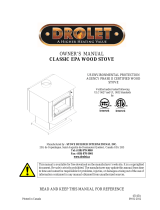 Drolet CLASSIC WOOD STOVE User manual
Drolet CLASSIC WOOD STOVE User manual
-
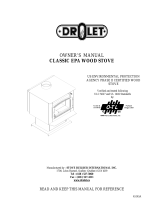 Drolet CLASSIC WOOD STOVE User manual
Drolet CLASSIC WOOD STOVE User manual
-
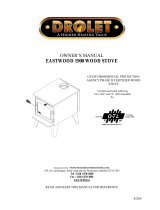 Drolet Stove 45284 User manual
Drolet Stove 45284 User manual
-
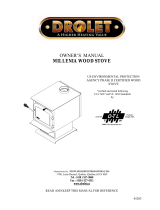 Drolet 45283 User manual
Drolet 45283 User manual
-
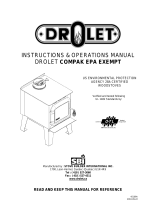 Drolet 45109A User manual
Drolet 45109A User manual
-
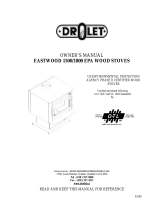 Drolet 1800 User manual
Drolet 1800 User manual
-
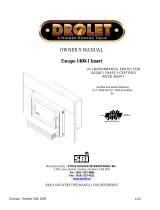 Drolet DB03120 User guide
Drolet DB03120 User guide
Other documents
-
Esse Ironheart Installation and Operating Instruction
-
Esse Ironheart Installation and Operating Instruction
-
Century 45398A User manual
-
Draper 1000 User manual
-
Century FW2470 User manual
-
 Century Heating FW2470 WOOD STOVE User manual
Century Heating FW2470 WOOD STOVE User manual
-
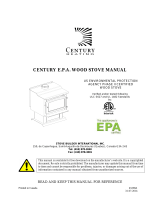 Century Heating FW2470 WOOD STOVE User manual
Century Heating FW2470 WOOD STOVE User manual
-
Century FW2470 WOOD STOVE User manual
-
GLAWNING 45 Degree Tent Stove Flashing Kit Operating instructions
-
HQ W9-CC-38H-B Datasheet













































